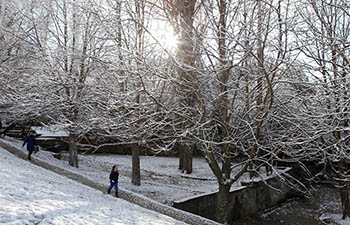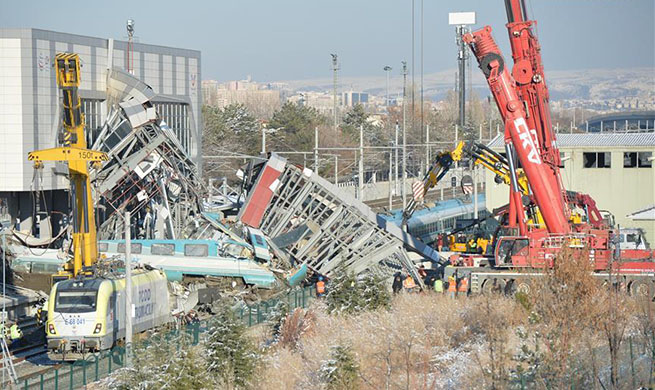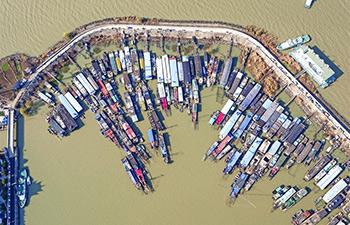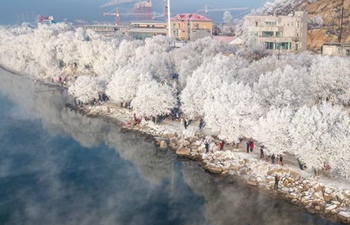WILMINGTON, the United States, Dec. 13 (Xinhua) -- Three months after Hurricane Florence hit North Carolina, parts of the southeastern state are still recovering from the aftermath as slow efforts and uncertainties overshadow prospects for local businesses and lives.
The usually busy tourist season in Wilmington, a port city in east North Carolina, ended abruptly this year after Florence made landfall nearby in mid-September as a Category 1 hurricane. It brought in strong winds and record-breaking rainfall and caused devastatation that scared many local residents.
Despite an evacuation order, local resident Michaela Morrissey and her friends didn't leave Wilmington when Florence was approaching. Instead they boarded up the house and windows and stockpiled food, water, gas and other supplies to ride out the storm. "The house shook, the windows were popping out and it was long," Morrissey recalled Florence's arrival.
The hurricane and its aftermath cut off Wilmington's traffic and power supply for quite a period of time. Morrissey told Xinhua that after Florence left "there was no way to get in and out of Wilmington so people couldn't bring food in."
"It was just like nobody was in town for a week. No power," she said. "It was weird. It was very empty."
When Tristen Harbowy returned to Wrightsville Beach, east of Wilmington, days after Florence's landfall, the damage it had done to the seaside resort were too visible to be ignored: houses were flooded, roofs destroyed and trees broken.
Harbowy said recovery has been going well so far but has also suffered a few setbacks due to sideswipes of a tropical storm and wet weathers, and those who were affected adversely by a hurricane two years ago are now facing "a very slow recovery."
Wilmington's tourism has suffered greatly. Harbowy said he witnesses "a pretty steep decline this season and probably a lesser turnout in the late season than normal." Morrissey, who works in a Wrightsville Beach restaurant, said local tourism "dropped off pretty drastically" and "a lot of restaurants were hit pretty bad."
A well-located grill house in Wrightsville Beach keeps its door closed to allow a complete renovation after rain water seeped in through the roof when Florence came. The owner told a local news outlet in October that the family business is nowhere close to reopening.
This year's Atlantic hurricane season concluded on Nov. 30 with above-average activities that had seen eight hurricanes, of which two were major. In the United States, Florence alone has taken over 50 lives and caused billions of U.S. dollars in damage.
Pollocksville, a riverside town about one and half hours of drive northeast of Wilmington, was not on the path that Florence's center moved inland. Though wind damage was not severe in Pollocksville, large storm surges from Atlantic Ocean and two consecutive days of rainfall led to a rise of river level by over 20 inches (around 51 cm) there, causing devastating flooding.
The town's park and boat docks were destroyed and the historic town hall was flooded and lost all of its records, while around 75 structures received between four inches (around 10 centimeters) and 12 feet (around 3.7 meters) of water, as the post office, several gift shops and the only restaurant were washed away.
Mayor James Bender told Xinhua that in Pollocksvill only houses adjacent to the river had flood insurance but the water reached far beyond flood-prone zones and flooded homes "that no one would ever believe would be flooded."
"Individuals, especially if you had no flood insurance, are struggling," he said.
The town government is looking at an estimated loss of 1.5 million dollars and has already applied for federal and state assistance, so have many local residents, but Bender admitted that would not be enough to cover their losses.
On the riverbank, several seriously-flooded, heavily mouldy houses were cleaned out. Internal renovation would start only after they dry out completely, a process that Bender said would take a long time. However, a bigger issue is that there are only a certain number of people who can do the work.
"I was talking to a contractor the other day and he has 260 jobs lined up," Bender said. "He doesn't know when he'll be finished."
A small town, Pollocksvill is split by U.S. Route 17, a north-south highway, with some 320 residents, most of whom evacuated due to the threats of the storm and flooding but three months on some have not yet returned.
Bender said the recovery effort is "slow" and they had been told a total recovery in Pollocksvill would take "five to seven years."













